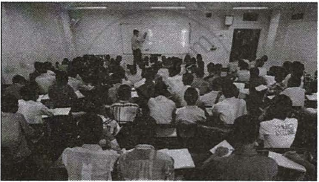Advertisements
Advertisements
Question
Solve for x and y:
2x + 3y + 1 = 0
`(7-4x)/3 = y`
Solution
The given equations are:
`(7-4x)/3 = y`
⇒ 4x + 3y = 7 ……..(i)
and 2x + 3y + 1 = 0
⇒2x + 3y = -1 ……….(ii)
On subtracting (ii) from (i), we get:
2x = 8
⇒x = 4
On substituting x = 4 in (i), we get:
16x + 3y = 7
⇒3y = (7 – 16) = -9
⇒y = -3
Hence, the solution is x = 4 and y = -3.
APPEARS IN
RELATED QUESTIONS
Find the value of k for which each of the following system of equations have no solution :
2x + ky = 11
5x − 7y = 5
Find the value of k for which the system
kx + 2y = 5
3x + y = 1
has (i) a unique solution, and (ii) no solution.
Find the values of k for which the system
2x + ky = 1
3x – 5y = 7
will have (i) a unique solution, and (ii) no solution. Is there a value of k for which the
system has infinitely many solutions?
Determine the values of a and b so that the following system of linear equations have infinitely many solutions:
(2a - 1)x + 3y - 5 = 0
3x + (b - 1)y - 2 = 0
Solve for x and y:
0.4x + 0.3y = 1.7, 0.7x – 0.2y = 0.8.
In a cyclic quadrilateral ABCD, it is given ∠A = (2x + 4)°, ∠B = (y + 3)°, ∠C = (2y + 10)° and ∠D = (4x – 5)°. Find the four angles.
If the point of intersection of ax + by = 7 and bx + ay = 5 is (3,1), then find the value of a and b.
A pair of linear equations which has a unique solution x = 2, y = –3 is ______.
Find the value(s) of p in (i) to (iv) and p and q in (v) for the following pair of equations:
2x + 3y = 7 and 2px + py = 28 – qy,
if the pair of equations have infinitely many solutions.
Read the following passage:
|
A coaching institute of Mathematics conducts classes in two batches I and II and fees for rich and poor children are different. In batch I, there are 20 poor and 5 rich children, whereas in batch II, there are 5 poor and 25 rich children. The total monthly collection of fees from batch I is ₹9,000 and from batch II is ₹26,000. Assume that each poor child pays ₹x per month and each rich child pays ₹y per month.
|
Based on the above information, answer the following questions:
- Represent the information given above in terms of x and y.
- Find the monthly fee paid by a poor child.
OR
Find the difference in the monthly fee paid by a poor child and a rich child. - If there are 10 poor and 20 rich children in batch II, what is the total monthly collection of fees from batch II?

